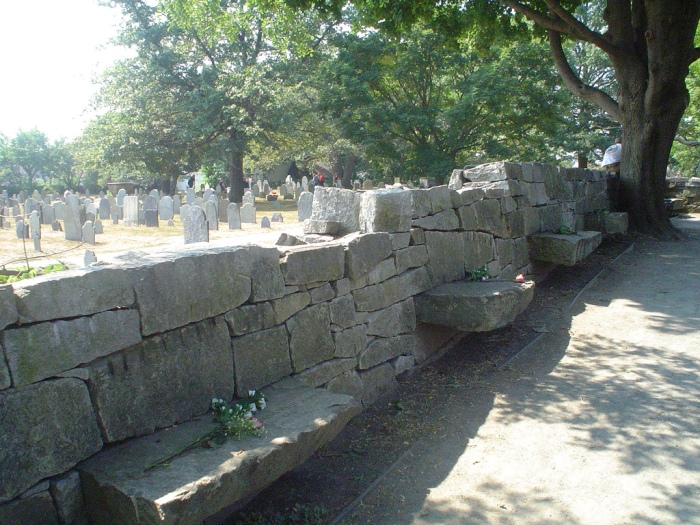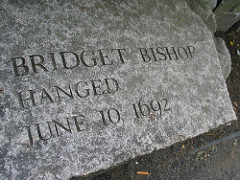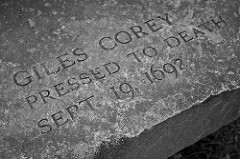
Is repentance a virtue? Can sites of repentance that memorialize trauma and injustice help us be better people?
If you believe that human nature inherently strives to embrace good and repudiate evil, you might see some affirmation of this in the fate of Salem, Massachusetts. I recently visited Salem to witness its evolution from the sleepy, working-class Boston suburb I once knew from childhood visits with my grandparents to the “Witch City” it is today, replete with police cars and fire trucks sporting the logo of a woman in a pointed hat on a broom, silhouetted against a full moon. Salem’s official and unofficial memorials to the witch persecutions of 1692 constitute a vibrant reclamation of diversity in a town that, more that 300 years later, is still best known for a brief, violent assertion of political and religious authority that famously scapegoated unconventional women, the poor, and those that defended them. To witness Salem’s contemporary celebration of everyday magic is to sense the yearning for justice that exists in human hearts and manifests itself through participatory gestures of generosity and tolerance, but it is also to reflect on the guilty, melancholic repetitions that can mark recognition of those common, human tendencies–cowardice, rage, envy, and intolerance–that reside in each of us.
In Salem today, official sites of mourning and memory exist alongside tawdry museums filled with lurid, full-sized dioramas depicting medieval dungeons, instruments of torture, and store mannequins dressed like Puritan matrons hanging from gallows. Contemporary Salem has occult boutiques on every corner peddling witch souvenirs and New Age collectibles to tourists while also selling candles, sage, incense, spell ingredients, Wiccan jewelry, and tarot cards to aspiring everyday witches and wizards. Witch tours start at dusk at the old Town Hall, variously led by history buffs, maritime enthusiasts, ghost story aficionados, sympathetic pagans, and practicing Wiccans. It is said that there are anywhere between 800 and 1600 witches living in Salem today, and there is even a Witches Education Bureau. A sculpture of Elizabeth Montgomery—the actress from the 1960s television series “Bewitched”—sits on a crescent moon in a town park. A brand new feminist group formed in Salem just this May gives thanks on their web page that such groups are easily started there because the town has “the coolest little aliens” residing in it.

Many countries have places that memorialize injustice, places where the act of remembering takes on ethical significance. In the U.S. these sites can be official, like the Wounded Knee Memorial that pays tribute to the 1890 massacre of Lakota men, women, and children by the U.S. Army; and unofficial, like Martin Luther King Jr.’s room at the Lorraine Hotel in Memphis, preserved for years by owner Walter Bailey to reflect the way it looked on the day the Civil Rights leader was fatally shot there, long before the hotel finally became The National Civil Rights Museum in 1991.
In its report “The Urge to Remember: The Role of Memorials in Social Reconstruction and Transitional Justice,” the Memorialization Working Group of the Institute of Peace in Washington, D.C. identifies the goals of memorializing conflict and injustice as reconciliation and social reconstruction. The function of memorials, they argue, should be to create a place to mourn, a place that symbolizes a community’s or nation’s commitment to human rights, and a place where symbolic reparations can be offered to victims of injustice.
Salem’s great injustices were directed primarily at women, so it is fitting that the town has become a haven for witches and feminists. Tour guides in Salem like to point out the innocuous fountain in the middle of town, recently built on the site of the town’s original fresh water spring. This busy thoroughfare of shops and restaurants was once the perfect spot for public humiliation, where residents came daily to fetch fresh water, walking past offenders displayed in chains or locked to wooden racks as punishment for adultery, fornication, gossip, and general insubordination. Here women who talked too much were pinioned for hours with bridles on their heads and metal bits pulling their lips back from their teeth, their suffering a warning to others that scolds and social rebels would not be tolerated by the town fathers.

The mournful old homesteads I remember visiting as a child still draw tourists; Nathaniel Hawthorne’s family House of the Seven Gables and Judge Jonathan Corwin’s “Witch House” hunch their shoulders suspiciously against the sky as scores of pilgrims pay their respects, marching through residential and commercial neighborhoods in search of clues as to why this particular town went out of its mind three hundred and twenty-four years ago, charging nearly two hundred people with witchcraft and brutally executing twenty of its citizens, including socially prominent elderly men and women in their seventies and eighties.
In the center of Salem sits the Old Burying Point, with many of its gravestones dated before 1800 and featuring winged skulls and angels on their arched tops. Next to this, running all along one side, a granite wall encloses a long rectangle, open at one end and punctuated by shade trees. Twenty stone benches jut out from the sides of the wall, each inscribed with a name and cause and date of death. This is the Salem Witch Trials Memorial.
The dates on the stones, all from 1692, are precise and evenly spaced throughout the summer: June 10, July 19, August 19, September 19, September 22. The memorial was dedicated by Elie Wiesel, who travelled there in 1992 to give a speech three hundred years after that terrible season. Looking around at the benches ringing the little yard, one is struck by how many memorial stones there are here. The number of benches, each with its quiet dignity, reminds us here that there were not three, or four, or five people executed for witchcraft in Salem, as movies about the trials often suggest, but the unthinkable number of twenty, with scores more languishing in prison, some in cells below sea level where the ocean crept in twice a day to torment them.

The memorial itself stands in somber contrast to the tacky exuberance of Salem’s witch tourism. On one end, its artists designed the wall to look as if it had been lifted, flipped over, and separated from the rest of the structure, revealing stones on the ground carved with words taken from the defendants in their trial transcripts. While many of those hanged were buried anonymously on Gallows Hill, here the bench stones with the names of each victim, and the front stones with their words refuting accusations of witchcraft and sorcery, work together to resist the silencing and erasure performed by the executions.

The Memorial’s bench stones show Bridget Bishop as the first to die, a lone victim hanged in June. By the end of July we learn she was joined by five women, including Rebecca Nurse, a devout grandmother of 71 years. We see that four men and a woman were executed in August, including Giles Cory and his wife, who spoke out against the terror. Giles was pressed to death at the age of eighty for his famous refusal to stand trial, an act that meant certain death for him but the retention of his farm for his remaining family. In the dates, we note the shocking escalation of deaths, as nine more people are killed on one day in September.

Although more would be convicted and sentenced to death before they were pardoned and released, September 22 marks the end of the executions. Five people accused in Salem died in prison. Five more people escaped. The whole mess finally began to unravel in earnest when the governor’s wife was accused; those remaining in prison were eventually exonerated or had their charges dropped. Public outcry against the trials was immediate and sustained, and the next three centuries witnessed attempts by moral leaders and families of the victims to clear the names of those executed. However, while many convictions were overturned in

1711, and still others as late as 1957, it was not until 2001 that Massachusetts finally exonerated all its convicted witches name by name.
Some scholars have argued that the weather is to blame for what happened in Salem, as the charges and arrests began during what has been termed the “Little Ice Age,” a period characterized by unusually cold winters and dry summers. Others blame the political and religious conflicts in Salem, Salem Village, and the surrounding towns, where many locals

enjoyed quarreling over property lines, inheritance laws, and religious doctrine. A strong case can be made for misogyny as one important factor in the trials, since the first people accused were uppity women, and class warfare as another, since the initial batch of accused were poor, and subsequent accusations were directed at wealthier landowners by those coveting their property and social status.
Climate change, political conflict, intolerance, misogyny, class warfare. We like to think that Salem could never happen again, but it is precisely this kind of forgetting that makes the work of memorializing injustice so important today. Salem has responded to its past with lively entrepreneurial exuberance, tolerance of diversity, and solemn respect, yet one can’t help marveling that a town that once turned on itself with such ferocity, and subsequently struggled for years to distance itself from those events, is now almost completely defined and shaped by that moment and its subsequent responses to it, living inside a story it tells over and over, as if compelled to echo that disaster, and the many voices that might have averted it, for eternity.

Jaime Hovey is Associate Program Director for Virtue, Happiness, & the Meaning of Life.